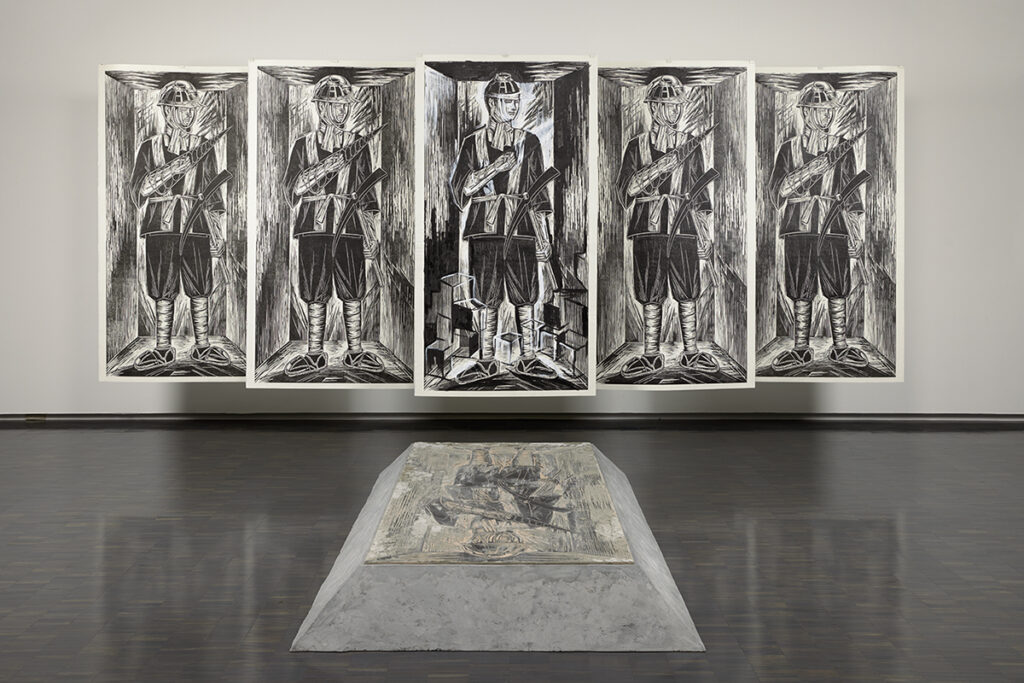Watch, Read, Listen
Recent Additions to the Collection MOMAT Collection Newsletter of the National Museum of Modern Art, Tokyo Kazama Sachiko, CEMENT MORI, 2020
Back
CEMENT MORI
2020
5 prints (four woodcut and one woodcut with acrylic and gesso), woodblock and cement
dimensions variable; each 182.2×91.2cm (woodcut)
Photo by Otani Ichiro
These five enormous woodblock prints suspended from the ceiling depict laborers with traditional miners’ attire and tools: helmets, picks, workman’s happi coats, aprons, gaiters, and straw sandals. In front of the prints is a concrete block resembling a tombstone, upon which a woodblock partially encrusted with hardened cement is placed. Are the workers gravediggers, tomb guardians, or perhaps the departed resting in the ground? The title CEMENT MORI evokes the Latin phrase memento mori urging contemplation of death, and the work’s similar urging seems key to deciphering its meaning.
This work first appeared in Kazama’s solo exhibition Cement Cemetery1 at MUJIN-TO Production in 2020. This show consisted of the new works Cement Cemetery and CEMENT MORI in addition to her Kurobe Gold series, first presented in the exhibition Concrete Suite2 at the Kurobe City Art Museum in 2019. Kurobe Gold is a set of six prints that juxtapose the development of the Kurobe River area, carved out of the natural environment in the process of modernization, with human desire for control as portrayed in Wagner’s opera Der Ring des Nibelungen. In Cement Cemetery, the process of limestone mines turning into gravestones is represented through frottage, and in the same vein, CEMENT MORI also has the theme of the human ego as seen in our ongoing quest to dominate nature. The work evokes death, and the first death it brings to mind is that of nature destroyed by human hands.
Meanwhile, this work is distinguished from her series of woodblock prints with a similar theme by its concrete base, inspired by subslab concrete. Cement, the raw material for concrete, is made by crushing limestone, which has formed over hundreds of millions of years through the cycle of birth and death of organic matter. Thus, concrete can also be seen as a grave for corals and microorganisms. In this piece, the most striking presences are those of the five workers appearing before us like ghosts. The four workers on the right and left have tools resembling drills in their right hands, implying the accelerated destruction accompanying mechanization. The central figure clasps clenched fists in front of his chest, evoking the plight of countless, nameless workers sacrificed for industrial progress. We should also recall the history of how printmaking, Kazama’s medium, contributed to the growth of the labor movement after World War II.
CEMENT MORI superimposes the deaths of the natural environment, organic matter, and laborers, and Kazama’s stunningly crisp linear engraving and jet-black ink confronts us with the profound costs of societal progress.
[Notes]
1.Kazama Sachiko, Cement Cemetery, MUJIN-TO Production, February 8 –March 8, 2020. 2. Kazama Sachiko: Concrete Suite [25th Anniversary of the Kurobe City Art Museum], October 12 – December 22, 2019.
(Gendai no me, Newsletter of The National Museum of Modern Art, Tokyo No.638)
Release date :


